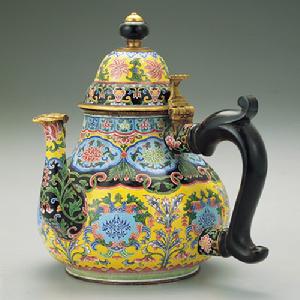Creating Beijing enamel art
 |
The skill and workmanship have been handed down from the Ming Dynasty. Since the founding of new China, quite a number of new varieties have been created. It enjoys a high reputation both at home and abroad with most of its products for export.
Three styles of cloisonné are most often seen: concave, convex, and flat. The finishing method determines this final appearance. With concave cloisonné the cloisons are not completely filled. Capillary action causes the enamel surface to curve up against the cloisonné wire when the enamel is molten, producing a concave appearance. Convex cloisonné is produced by overfilling each cloison, at the last firing. This gives each color area the appearance of slightly rounded mounds. Flat cloisonné is the most common. After all the cloisons are filled the enamel is ground down to a smooth surface with lapidary equipment, using the same techniques as are used for polishing cabochon stones. The top of the cloisonné wire is polished so it is flush with the enamel and has a bright luster. Some cloisonné enamel is electroplated with a thin film of gold, which will not tarnish as silver does.
All the products are beautiful and elegant in molding, brilliant and dazzling in colors and splendid and graceful in design. It is a famous local handicraft in the Beijing region.
















